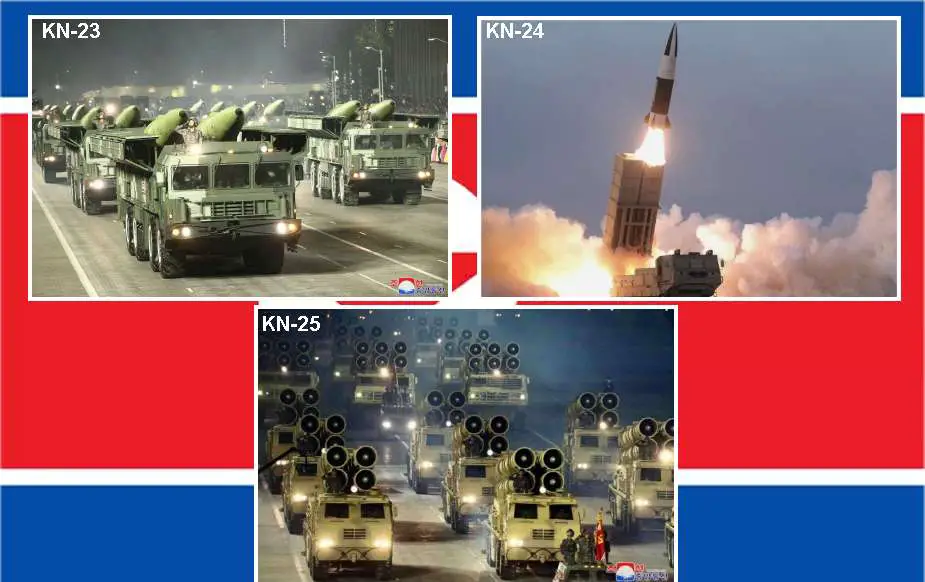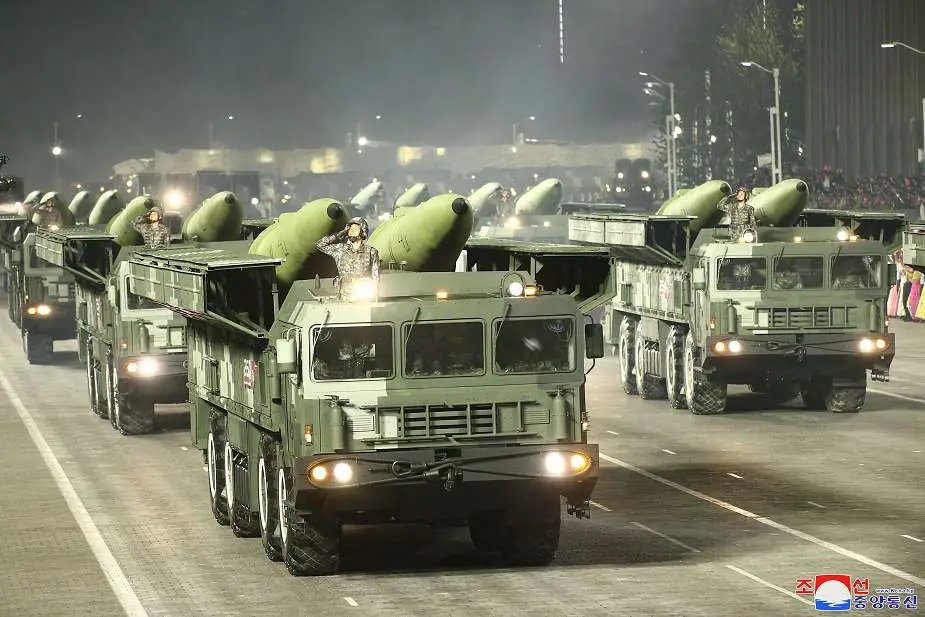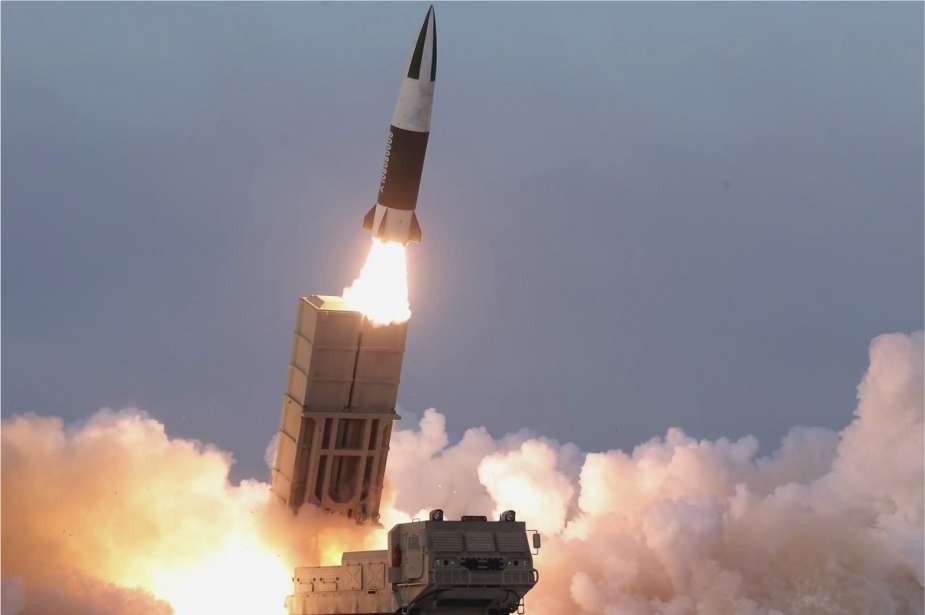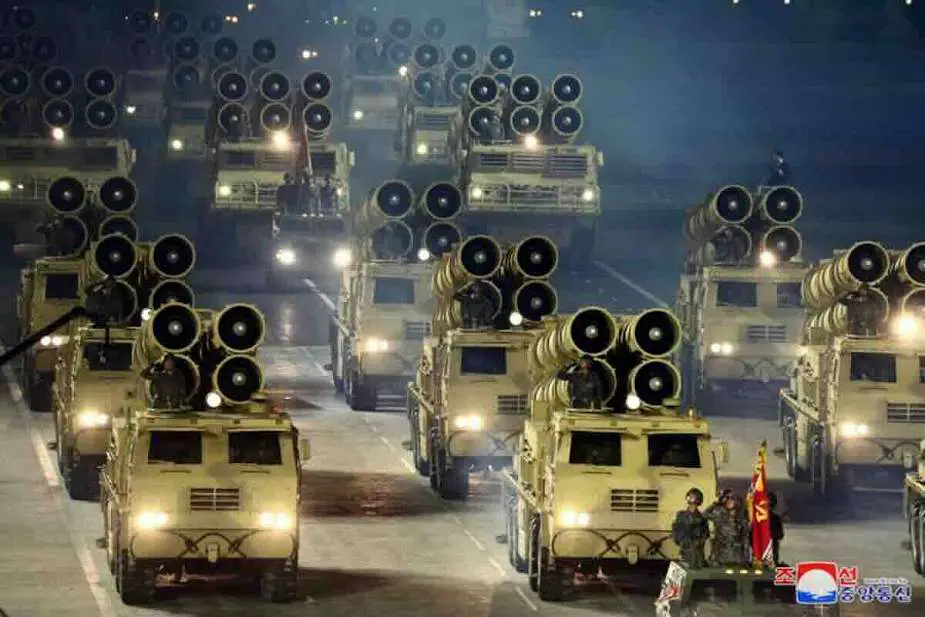Breaking news
North Korea to Supply Russia with Ballistic Missiles to Support Military Operations in Ukraine.
South Korean army intelligence services have reported that North Korea has been supplying a range of ballistic missile systems to Russia, potentially bolstering Russian military capabilities in the ongoing conflict in Ukraine. The delivery includes Short-Range Ballistic Missiles (SRBMs) and multiple launch rocket systems (MLRSs), as well as a substantial quantity of artillery ammunition.
Follow Army Recognition on Google News at this link

North Korea to supply Russia with different types of ballistic missile systems. (Picture source KCNA)
The South Korean Armed Forces have identified three types of SRBMs (Short-Range Ballistic Missiles) that are likely being shipped to Russia: the KN-23, KN-24, and the KN-25, the latter of which is referred to as a "super-large caliber" MLRS (Multiple Launch Rocket System) but is categorized by South Korea as a ballistic missile system due to its capabilities.
"The Korea Herald" reported on November 2, 2023, that North Korea is suspected of having provided 122mm rockets and 152mm artillery shells, both of which are compatible with Russian military equipment currently in use.
An official statement from Seoul disclosed that approximately 2,000 containers have been transported to Russia via the Rajin Port since August 2023. The volume of the munitions is considerable: if the containers were filled with 122mm rockets, the total would exceed 200,000 rounds; if with 152mm artillery shells, the number would surpass 1 million rounds.
These revelations have not only raised eyebrows in international circles but also posed significant implications for the balance of power in the Ukrainian conflict. The delivery of such a large cache of munitions could signal a deepening of the military cooperation between North Korea and Russia.

The KN-23 is a mobile ballistic missile system that seems very similar to the Russian-made Iskander. (Picture source KCNA)
KN-23:
The KN-23 is a short-range ballistic missile (SRBM) developed by North Korea, which has been compared to Russia's Iskander missile due to its similar design and capabilities. It is known for its ability to perform pull-up maneuvers during the terminal phase of its flight, which makes it more difficult to intercept with missile defense systems. The missile is designed to be mobile and is launched from a transporter erector launcher (TEL), enhancing its survivability and the ability to launch from various locations.
Technically, the KN-23 is characterized by its solid-fuel propulsion, which allows for quicker launch preparations compared to liquid-fueled missiles. It has a reported range of approximately 600 kilometers and is capable of carrying a nuclear or conventional warhead. The missile's flight pattern is distinct in that it follows a quasi-ballistic trajectory, flying at lower altitudes and performing unpredictable maneuvers, which complicates tracking and interception efforts. This capability, combined with its accuracy and range, makes it a strategic asset in North Korea's military arsenal, aimed at countering regional adversaries and reinforcing its deterrent posture.

The KN-24 is a North Korean short-range ballistic missile (SRBM) first tested in August 2019. (Picture source KCNA)
KN-24:
The KN-24 is a North Korean short-range ballistic missile (SRBM) that was first tested in August 2019. It is a single-stage, solid-fueled missile that is road-mobile, enhancing its operational flexibility. The KN-24 bears a resemblance to the American MGM-140 ATACMS and is believed to serve a similar role in providing tactical support on the battlefield. It has a reported operational range of approximately 410 kilometers and is capable of carrying a payload of 400–500 kilograms, which could include either conventional or unconventional warheads. The missile's design includes fixed aft-mounted aerodynamic fins and it is deployed from rectangular launch canisters, suggesting a focus on rapid deployment and launch readiness.
In terms of technical features, the KN-24 is notable for its ability to fly on a quasi-ballistic trajectory, which includes flying at lower altitudes to maintain aerodynamic control throughout its flight path and potentially evade missile defense systems. This missile is also capable of performing "pull-up maneuvers" during flight, a characteristic that could be used to orient onboard targeting systems or to avoid interception. The KN-24's guidance system includes an inertial navigation system (INS), and it may also utilize satellite navigation for improved accuracy. The missile's accuracy is suggested to be within 35 meters, and it has demonstrated the capability to strike targets with precision, as evidenced by one test where it hit a small island target. The KN-24 is expected to replace older, less accurate liquid-fueled North Korean SRBMs, representing an advancement in North Korea's missile technology and tactical capabilities.

The KN-25 is a new 600mm MLRS Multiple Launch Rocket System able to launch short-range ballistic missiles. (Picture source KCNA)
KN-25:
The KN-25 is a potent artillery rocket system from North Korea, distinguished by its use of 600 mm guided artillery rockets, making it the most formidable multiple launch system in the country's arsenal. Demonstrated in tests during 2019 and 2020 and showcased in a military parade, the KN-25 is believed to be actively produced and fielded by the North Korean military. Its rockets, some of the largest of their kind, have shown a range of 240 km and are estimated to potentially reach up to 400 km, effectively putting most of South Korea within striking distance. These rockets are precision-guided, utilizing inertial and satellite navigation, and are rumored to be capable of carrying nuclear warheads. The vehicle is able to launch short-range ballistic missiles derived from the Russian OTR-21 Tochka.
Mounted on a modified Tatra chassis with a unique independent suspension system, the KN-25 launcher vehicle carries four rockets in containers, capable of launching at 20-second intervals and reloading using a crane. The vehicle is designed with an armored cab to protect the crew from small arms fire and artillery splinters, as well as the rocket engine's exhaust. It features a roof hatch with a ring mount, is diesel-powered, has an 8x8 drive configuration, and is equipped with a central tire inflation system for enhanced off-road capability.
Defense News November 2023




























